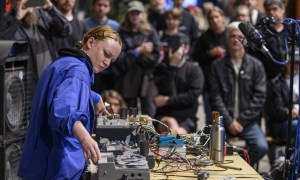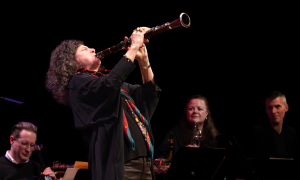Home » Jazz Articles » Live Review » Festival International Musique Actuelle Victoriaville: D...
Festival International Musique Actuelle Victoriaville: Day 2 - May 21, 2010
Festival International Musique Actuelle Victoriaville
Victoriaville, Quebec, Canada
May 21, 2010
Friday, Day 2 of FIMAV, started with a double feature at 2:00 in the afternoon, with two more Quebec-based acts, underscoring the impression that a new musical language and field is really promising to blossom in this province, however marginal it may appear in the larger scheme of things. One set, by a trio calling itself Bold, showcased improvised industrial work. The other was a string quartet with electric bass and drums, playing a composition by Eric Normand.
Bold consisted of Nicolas Bernier on an electronically bolstered mini drum kit; Erick D'Orion on laptop and electronics; and Alexis Bellavance on electric table guitar. Their piece came on hard, like trucks zooming down a tunnel, or trash barrels rolling down an alley. This was all at a reduced pace, so the rhythm only became apparent with close, accumulated attention. The nastiness, scariness and ugliness of the noise were belied by the effortless care with which the trio handled its equipment, turning ugly into beautiful. The piece lost some momentum as it went on but was tied up eloquently with a swift ending, unpredictably capping off a fadeout.
 From left: Michel Langevin, Martin Dumais, Julie Leblanc
From left: Michel Langevin, Martin Dumais, Julie Leblanc
Normand's "Musique de batailles" started off as an off-putting exercise in dissonance and lax, lapsing tempo. It was disturbing in the way that mosquitoes, heavy with blood, can be disturbing—though in the long run it may be that this contrarian ethic was precisely what was at stake here. Normand dared his audience to find strain and stress in his work, then turned seducing when least expected, either with the otherworldly eeriness of what he was doing, or by introducing an infectious rock theme into the stream. The composition worked with this alternation between seduction and repulsion, and was ultimately an intriguing success.
What to make of Les Filles Electriques, the evening's opening act, was another story. Again, though, liking it or not may not have been the issue: it was what it was, a "happening." A series of spoken word pieces were delivered by various men and women against a back drop of muddy, jangly drums, guitar and electronics. The content, for what it was worth, was quite random—and, more to the point, seemed culture-bound to a degree, focusing on humor shared by the French Catholic women featured in the act. In the end, the music didn't seem to be the point.
Aun & Michel Langevin shared a double bill at 10:00 PM with the erstwhile no-wave heroine, Lydia Lunch. This was a true one-two punch, an ambient, chill-out metal act followed on its heels by a spoken-word fury of a performance piece.
Aun consists of a guitarist, Martin Dumais, with Julie Leblanc on video and synthesizer. Langevin was the drummer, impeccable and mighty, propelling the duo into ever more intense realms of agitation that, for all that, remained tame and manageable to the ear. Japanese bands like The Ruins and Altered States came to mind, the way a structure on a guitar persisted statically, only to be washed away ultimately by its own inertia, until the drummer hurled his sound darts at it and it reached a more supernal way of sonic being. A study of touchstones or influences on Dumais would be sure to include the great Michael Rother, of the early '70s German band Neu!, a group that similarly mastered time by resisting it. This was another highlight of the festival.
 Lydia Lunch
Lydia Lunch
Yet another was Lunch, accompanied by Phillippe Petit on "vinyl, objects and electronics." Lunch wound out her rhetorical marathon over the space of about 50 minutes, touching upon everything and nothing. She seemed inexhaustible, riding her wave with blinding vision, analyzing her own persona and her particular enigmatic, irresistible star quality which draws men to her, seeking to "get a piece" of her without knowing what that piece really is—and how nothing is a haven and we are never safe; but how at the same time she can see right through us and, as if to prove the point, she directed the green-colored stage lights directly at the audience.
Lunch was a shockingly pleasant surprise, making good on her reputation as sometime front girl for Teenage Jesus and the Jerks. Les Filles Electriques have her to look up to as a model of sheer force and torque, however different their own message might be.
Photo Credit
All Photos: Martin Morissette
Tags
PREVIOUS / NEXT
Support All About Jazz
 All About Jazz has been a pillar of jazz since 1995, championing it as an art form and, more importantly, supporting the musicians who make it. Our enduring commitment has made "AAJ" one of the most culturally important websites of its kind, read by hundreds of thousands of fans, musicians and industry figures every month.
All About Jazz has been a pillar of jazz since 1995, championing it as an art form and, more importantly, supporting the musicians who make it. Our enduring commitment has made "AAJ" one of the most culturally important websites of its kind, read by hundreds of thousands of fans, musicians and industry figures every month.


























